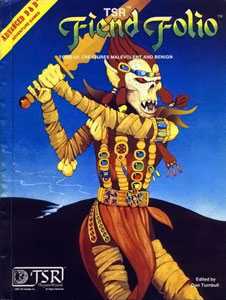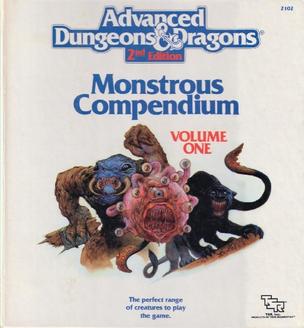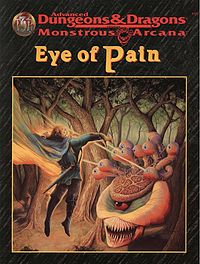| Front cover | |
| Author | Aaron Allston |
|---|---|
| Genre | Role-playing games |
| Publisher | TSR |
Publication date | 1996 |
| Media type | Book |
I, Tyrant [1] is an accessory for the 2nd edition of the Advanced Dungeons & Dragons fantasy role-playing game.
| Front cover | |
| Author | Aaron Allston |
|---|---|
| Genre | Role-playing games |
| Publisher | TSR |
Publication date | 1996 |
| Media type | Book |
I, Tyrant [1] is an accessory for the 2nd edition of the Advanced Dungeons & Dragons fantasy role-playing game.
I, Tyrant is a supplement which provides further details about beholders from what is given in the Monstrous Manual , including information about the history of beholders as a race, and their religion, culture, settlements and psychology, and game statistics on beholder deviants. [2] The book also provides rules for psionics and magic items available to beholders. [2]
I, Tyrant was published by TSR in 1996 as a 93-page book. It was designed by Aaron Allston, and featured cover illustrations by Dana Knutson, and interior illustrations by Arnie Swekel, David Martin, Glen Michael Angus, William O'Connor, and Randy Post.
I, Tyrant and the module Eye of Pain were the first publications from TSR in their "Monstrous Arcana" series, which details the most popular AD&D monsters. [2]
David Comford reviewed I, Tyrant for Arcane magazine, rating it an 8 out of 10 overall. [2] He comments: "As if these multi-eyed nightmares weren't deadly enough, now they can have magical items and psionics too." [2] He notes that through I, Tyrant, "the amazing versatility of the race is depicted in great detail, raising them from merely a collection of interesting monsters to a curious and powerful civilisation. The results give referees a myriad of encounter opportunities and possibilities for inserting beholder NPCs into existing campaigns for that extra punch of spice." [2] Comford concludes his review by stating: "The Monstrous Manual will still suffice for brief encounters with these creatures, but through expanded details on the creatures' behavior, powers, driving forces and tips on how to defeat them, I, Tyrant is useful to referees or players planning to embark upon a beholder-heavy adventure." [2]

In the Dungeons & Dragons fantasy role-playing game, illithids are monstrous humanoid aberrations with psionic powers. In a typical Dungeons & Dragons campaign setting, they live in the moist caverns and cities of the enormous Underdark. Illithids believe themselves to be the dominant species of the multiverse and use other intelligent creatures as thralls, slaves, and chattel. Illithids are well known for making thralls out of other intelligent creatures, as well as feasting on their brains.
A gelatinous cube is a fictional monster from the Dungeons & Dragons fantasy role-playing game. It is described as a ten-foot cube of transparent gelatinous ooze, which is able to absorb and digest organic matter.

The Monster Manual is the primary bestiary sourcebook for monsters in the Dungeons & Dragons fantasy role-playing game, first published in 1977 by TSR. The Monster Manual was the first hardcover D&D book and includes monsters derived from mythology and folklore, as well as creatures created specifically for D&D. Creature descriptions include game-specific statistics, a brief description of its habits and habitats, and typically an image of the creature. Along with the Player's Handbook and Dungeon Master's Guide, the Monster Manual is one of the three "core rulebooks" in most editions of the D&D game. As such, new editions of the Monster Manual have been released for each edition of D&D. Due to the level of detail and illustration included in the 1977 release, the book was cited as a pivotal example of a new style of wargame books. Future editions would draw on various sources and act as a compendium of published monsters.
The beholder is a fictional monster in the Dungeons & Dragons fantasy role-playing game. It is depicted as a floating orb of flesh with a large mouth, single central eye, and many smaller eyestalks on top with powerful magical abilities.

Fiend Folio is the name of three separate products published for successive editions of the fantasy role-playing game Dungeons & Dragons (D&D). All three are collections of monsters.

The Monstrous Compendium is a series of accessories for the Advanced Dungeons & Dragons fantasy role-playing game released from 1989 to 1998. The title was then used for a series of 5th Edition Dungeons & Dragons supplements released on D&D Beyond.
An owlbear is a fictional creature originally created for the Dungeons & Dragons fantasy role-playing game. An owlbear is depicted as a cross between a bear and an owl, which "hugs" like a bear and attacks with its beak. Inspired by a plastic toy made in Hong Kong, Gary Gygax created the owlbear and introduced the creature to the game in the 1975 Greyhawk supplement; the creature has since appeared in every subsequent edition of the game. Owlbears, or similar beasts, also appear in several other fantasy role-playing games, video games and other media.
In the Dungeons & Dragons fantasy role-playing game, the mimic is a type of fictional monster. It is portrayed as being able to change its shape to disguise its body as an inanimate object, commonly a chest. The mimic uses a powerful adhesive that holds fast to creatures that touch it, allowing the mimic to beat its victims with its powerful pseudopods. The mimic was introduced in the first edition Advanced Dungeons & Dragons game's original Monster Manual. The mimic has appeared in subsequent editions. Several variants of the creature have been introduced, with a variety of abilities and sizes.

In the Dungeons & Dragons fantasy role-playing game, goblins are a common and fairly weak race of evil humanoid monsters. Goblins are non-human monsters that low-level player characters often face in combat.

In the Dungeons & Dragons fantasy role-playing game, giants are a collection of very large humanoid creatures based on giants of legend, or in third edition, a "creature type".
The lich is an undead creature found in the Dungeons & Dragons (D&D) fantasy role-playing game. Liches are spellcasters who seek to defy death by magical means.
In the Dungeons & Dragons fantasy role-playing game, a vampire is an undead creature. A humanoid or monstrous humanoid creature can become a vampire, and looks as it did in life, with pale skin, haunting red eyes, and a feral cast to its features. A new vampire is created when another vampire drains the life out of a living creature. Its depiction is related to those in the 1930s and 1940s Hollywood Dracula and monster movies. In writing vampires into the game, as with other creatures arising in folklore, the authors had to consider what elements arising in more recent popular culture should be incorporated into their description and characteristics.

The Isle of Dread is an adventure for the Dungeons & Dragons role-playing game. The adventure, module code X1, was originally published in 1981. Written by David "Zeb" Cook and Tom Moldvay, it is among the most widely circulated of all Dungeons & Dragons adventures due to its inclusion as part of the D&D Expert Set. In the adventure, the player characters arrive on the Isle of Dread seeking a lost treasure, and there encounter new nonhuman races.
Tritons are a fictional species in the Dungeons & Dragons fantasy role-playing game.

Night Below: An Underdark Campaign, often known as Night Below, is a boxed set for the second edition of the Advanced Dungeons & Dragons fantasy role-playing game. The set, with the product code TSR 1125, was published in 1995, and was written by Carl Sargent, with box cover art by Jeff Easley.

Psionic Artifacts of Athas is an accessory for the 2nd edition of the Advanced Dungeons & Dragons fantasy role-playing game, published in 1996.

Eye of Pain is an adventure for the 2nd edition of the Advanced Dungeons & Dragons fantasy role-playing game.

Defilers and Preservers: The Wizards of Athas is an accessory for the 2nd edition of the Advanced Dungeons & Dragons fantasy role-playing game.

In the Dungeons & Dragons fantasy role-playing game, the term monster refers to a variety of creatures, some adapted from folklore and legends and others invented specifically for the game. Included are traditional monsters such as dragons, supernatural creatures such as ghosts, and mundane or fantastic animals. A defining feature of the game is that monsters are typically obstacles that players must overcome to progress through the game. Beginning with the first edition in 1974, a catalog of game monsters (bestiary) was included along with other game manuals, first called Monsters & Treasure and now called the Monster Manual. As an essential part of Dungeons & Dragons, many of its monsters have become iconic and recognizable even outside D&D, becoming influential in video games, fiction, and popular culture.